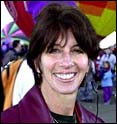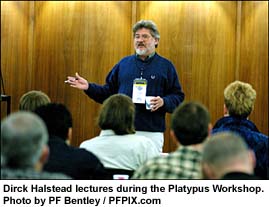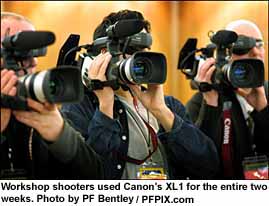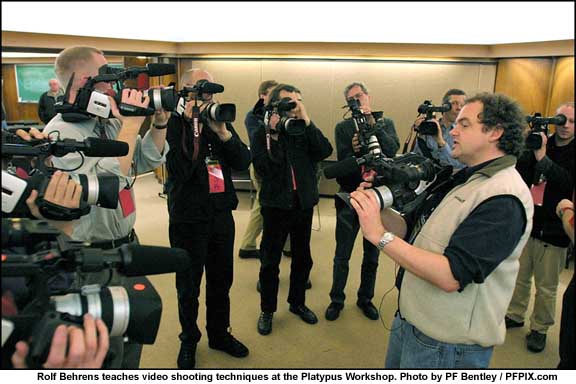|
Amy Bowers - TV Talk Mine is Smaller |
 |
|
I arrived in Norman, Oklahoma, just in time to share a solemn ritual of the Platypus Workshop. At a campus hangout called Mr. Bill's, 27 photographers and their instructors were celebrating the halfway mark in their two-week long boot camp. Deprived of sleep, overloaded with information, humiliated by their initial efforts, and elated by their eventual success, they were, for the moment, at one with the universe. That oneness, supplemented with food and beverage underwritten by Canon U.S.A., included a good measure of video enlightenment. By the end of the first week, each of the ten teams, consisting of two or three people, had completed a one-minute video assignment. These short reports, well shot and nicely edited, on small format digital video, by the newly hatched Platypi, proved their ability to tell non-fiction video stories.
Many were freelancers, some were sent by their newspaper, and others were university students or professors. The following morning, unable to ignore the dismaying worldwide decline of photojournalism, Halstead told the troops, "Big changes are afoot; this is a very bad time to be any kind of visual journalist." He encouraged the still photographers in their efforts to become proficient in small format digital video production. With Platypus, the furry egg-laying tangle of mammalian confusion, as a mascot, the message is: become a hybrid, and let the others laugh at your strange little camera; the duckbill will thrive. Halstead offered the first Platypus Workshop in 1999 to thirty photographers who were not afraid to train in video. The workshop was conducted in Norman, Oklahoma, coinciding with the yearly training of TV shooters offered by the National Press Photographers Association. The NPPA TV NewsVideo Workshop, known to many as simply, "The Workshop" is a six-day skills course offered to television professionals. The Platypus Workshop, packed with video virgins, most of whom had never used a mini-DV camera, ran twice as long, to accommodate the steep learning curve. In launch year 1999, the Platypus Workshop was tolerated as an ineffectual oddity by The NPPA Workshop's broadcast staff and mainstream participants. The following year, NPPA staffers began encouraging their students to check out the inexpensive but user-friendly digital editing systems used by the Platypi. This year, the fully enrolled Platypus Workshop was shown some respect by the NPPA team--for both the camera and edit systems and the photographers using them. John Premack, president and director of this year's shockingly under-subscribed NPPA Workshop told his TV shooters, Ê"The empty seats are a silent reminder of what's happening in our industry, of cutbacks in television." Of Platypus, he said, "For them, the future in now." The future, indeed, is in a transition driven by the economies and technologies of television and the World Wide Web. Three years ago, it looked as if the dot.com explosion would power the photojournalists of the future. This year, TV pros, who never really bought into the dot.com frenzy in the first place, have no clear expectations. The prevailing wisdom is: Everyone must be a producer, for television or new media. TV veterans who merely shoot and edit will be dinosaurs, eating from the shrinking food supply while it lasts. People who want to continue their careers as storytellers will leave television. TV news and newspaper photography will be entry-level jobs, low paying and dead end. Some broadcast stations will drop out of the TV news business, and cable will fill the need.
The Platypus class of 2001 grasped these concepts with ease. And, unlike the prior students, this was the first group not intimidated by the shoot and edit hardware and software. The teaching team of Rolf Behrens, from the TV news side of the industry, and PF Bentley from the world of magazine photojournalism (now a self-proclaimed Platypus) moved their students quickly through the training. The enrollees were also in Norman with the purpose of making contacts and getting advice to help them find outlets for their work. Fritz Nordengren, a multimedia producer, offered his suggestions during a special presentation to the Platypus Workshop. Nordengren, who develops and creates traditional and new media for non-profits, has an impressive background in the business side of journalism that dovetails perfectly with his creative talent in advertising, marketing, photography, and Web design. His company, New Media for Nonprofits (http://www.nmnp.org) designs media for major charities that do medical relief work. "Find a cause you believe in," says Nordengren, "and you are helping them with something they believe in." Nordengren graduated from the first Platypus Workshop in 1999, adding video storytelling to his skills in Web design, still photography, radio, and brochure design. He helps his clients select and create the appropriate format for their message. This can be as simple as launching a website for a Boy Scout troop, or as complex as providing streaming video for medical charities, like "Operation Rainbow," that do relief work. He emphasized the importance of establishing a business relationship with the client. "Nonprofit does not mean No Budget," he said, and cautioned workshop members from working for free. At the very least, charge them fifty bucks, he suggested. Nordengren praised the teams for taking two weeks of their time to travel to Oklahoma to learn something new. "There are two kinds of people," he continued. "The ones crying the blues, and the ones doing something about it. You are a very unique group of people. Instead of saying, 'The sky is falling!' you are taking a chance, taking a risk.... I hope you realize you have what it takes to change the face of storytelling. You are the visual journalists of the future." He encouraged each member of the Platypus class to choose a project and stay focused on it. Find a story, think about who will benefit from that story, and then contact those people and offer your services. Most nonprofits can go directly to contributors who will write a check for a specific project. "Don't give up!" said Fritz. "There will be a place for good content and well-told stories." "And," he assured them, "The people in this group are able to help you accomplish your goal." The goals this year were to tell stories from as far away as Uganda and Cambodia, to as close by as the neighborhood animal shelter. Most of these stories can be shot with a minimum of gear. Reversing the model of the burly TV cameraman with his large camera and overgrown lens, the era of small and smaller has arrived. Network and cable television executives have been signaling their acceptance of small digital video cameras and inexpensive edit systems for the production of what some call "non-scripted television." Memos have been circulated announcing the projected demise of the 3-4 person TV crew and the emergence of the crew of one. Expensive and bulky postproduction edit paks will give way to inexpensive software loaded in PowerBooks. Television reporters better learn to shoot, caution these TV executives; while shooters and audio technicians, on traditional TV crews, need to secure their futures by learning to research and write.
"My camera is smaller than your camera!" And furthermore, "my camera bag is tinier than yours!" were the cries of the Platypus faculty as they outdid one another proclaiming the virtues of simplicity. Faculty members PF Bentley, Dirck Halstead, and Rolf Behrens demonstrated their travel kits, emphasizing the importance of traveling light. Behrens, co-producer of several ABC Nightline stories, says, "I reduce things to the minimum. We've reached the stage where you can do it on your own." The light DV equipment allows him to continue to shoot, after back injuries prohibited him from hefting a traditional betacam. Halstead concurred: "I've greatly reduced my gear, my kit." Although he takes both still and video equipment on assignment, Halstead now brings two bags and a small tripod, less gear than he used to bring for his former still photography essays. PF Bentley vividly illustrated the value of portability with his hilarious description of getting in and out of Cuba last year, while traveling alongside the network television crews. PF was able to move and leave quickly with his two cordura bags, while "The Crew," burdened with "The Crew Gear," typically packed into fourteen cases weighing several hundred pounds, were delayed for hours by Cuban authorities. PF needed only a few minutes to demonstrate his kit. One bag holds his camera, portable light and tripod. The other, carries batteries, microphones, some diffusion filters and gels, a few clamps, cables, accessories, tape, and, we presume, a Leica and a change of clothes. The reverse boast of "Mine is Smaller Than Yours," continued, during the first weekend of the workshop, when Rolf Behrens and a television crew from Spanish-language TV started comparing flashlights, to see whose light was the better piece of equipment--providing low-light shooting--for its size. Small and smaller. The edit system used at Platypus 2001 was, once again, the Apple Final Cut Pro software, on the G4 computer. The program is extremely user-friendly and students were able to begin simple edit projects almost immediately. Behrens, a beta tester of Final Cut Pro, and a pioneer in its use for broadcast television, uses the system on his G4 PowerBook. The economies of the mini-DV technology for shooting and editing reality television are very impressive. But will the changeover from traditional media cause the product to suffer? That's a question pondered by John Premack, the NPPA president. Looking at the worldwide influx of brand new "visual storytellers," some unskilled and untrained, Premack takes a historical approach. Premack experienced the transition from news film to news tape in the middle 1970s and feels that the first years of the change in news gathering technology were, in fact, accompanied by a drop in quality. Some of the problems were created by jurisdictional disputes between electronic technicians and news film shooters. The techs had the background to guarantee the technical quality of the video signal, but no training in journalism or broadcast news. The newspukes had the know-how to cover a news assignment, but struggled with the constant adjustment of the video signal needed to keep the early ENG cameras within FCC specifications. Ultimately, some of the news film camera staff converted to electronic equipment, and those technicians who were the most willing to learn the requirements of TV news field production, endured. Eventually, the on-air quality of television news tape rebounded. At The Workshop in Norman, senior faculty members discussed their hopes for new opportunities to tell visual stories, and voiced their anxieties about the future of good solid visual journalism. Two cameraman/directors on the NPPA faculty, Darrel Barton and Bob Brandon, expressed their concern that the market now requires more work for less pay, for content providers. Premack forecasts a future in which TV news will be shot and reported by entry-level personnel, who will move up to management positions in television, or will leave TV to pursue more gainful employment. And what of the others, the visual storytellers, steeped in journalism, conviction, intelligence, and creativity? For now, The Platypus Workshop can only train and inspire them, and wait to see when and where the work of One Storyteller With a Laptop and Two Itty Bitty Bags will hit your monitor screen. Amy Bowers PF Bentley's Platypus Page: www.pfpix.com/platypus EQUIPMENT SITES:
SOFTWARE: http://www.apple.com/finalcutpro NATIONAL PRESS PHOTOGRAPHERS
ASSOCIATION: http://www.nppa.org
|
|
|
ARCHIVES
| PORTFOLIOS
| LINKS |
|
Read
Amy Bowers previous columns |
 "This
is one of the best groups we have ever taught," Dirck Halstead
said in an email advisory from Oklahoma. "Reflecting the reach
of The Digital Journalist, nearly one third of our students come from
overseas. One of our scholarship students is a photographer from Central
African Press in Nairobi. We also have a high concentration of students
from Scandinavian countries."
"This
is one of the best groups we have ever taught," Dirck Halstead
said in an email advisory from Oklahoma. "Reflecting the reach
of The Digital Journalist, nearly one third of our students come from
overseas. One of our scholarship students is a photographer from Central
African Press in Nairobi. We also have a high concentration of students
from Scandinavian countries." "Cameraman"
and "cameraperson" are no longer the preferred terms for TV
shooters at the NPPA TV NewsVideo Workshop. In fact, being a shooting
specialist is seen as a liability. Now the participants are being trained
to be "story tellers."
"Cameraman"
and "cameraperson" are no longer the preferred terms for TV
shooters at the NPPA TV NewsVideo Workshop. In fact, being a shooting
specialist is seen as a liability. Now the participants are being trained
to be "story tellers."